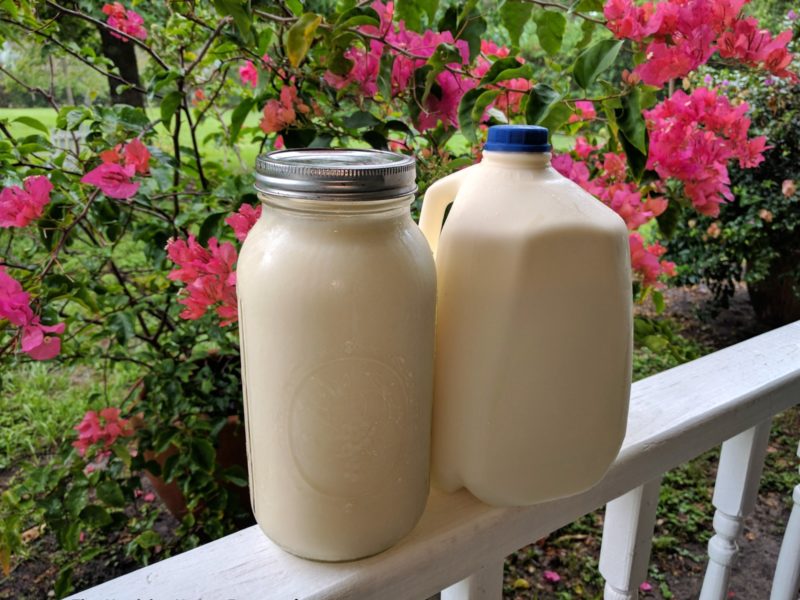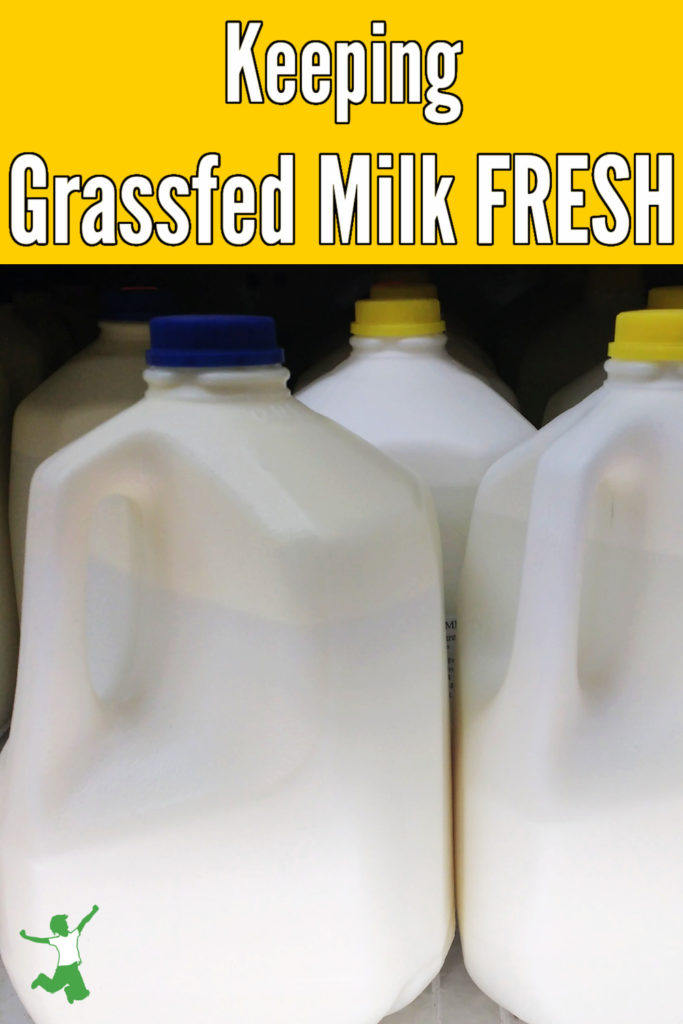How to keep grassfed raw milk fresh for drinking as long as possible so that your investment in Real Food is maximally used for your family’s health benefit.

When making the smart switch to unpasteurized milk from allergy-triggering pasteurized or ultrapasteurized (UHT) organic milk, a consumer needs to learn a few tricks of the trade right away. One of the most important is how to maintain raw milk freshness as long as possible.
Practically speaking, this is necessary because quality, fresh from the farm milk is usually at least double or even triple commercial milk prices (unless you buy at the farm and bring your own containers). You want every drop to stay fresh until you’ve used it up!
This is especially important for those who will use the grassfed milk for homemade baby formula.
As someone who has purchased and consumed raw grass-fed milk from over two dozen farms in many different states and countries over the past 2 decades, I thought I would pass along 5 important tips on how to make this happen in your home.
Quality, unpasteurized raw milk should easily remain fresh for drinking on average 10-14 days. In the summer, when the grass is mild and grows fast, I’ve found it will sometimes last 3 weeks or more.
If your farm doesn’t have milk that stays fresh this long, several things could be the problem.
A Large Creamline Locks in Raw Milk Freshness
The type of cow you get your milk from makes a huge difference to how long it lasts in the fridge.
Holstein (black and white) cows, produce milk with a decidedly small to nearly imperceptible cream line.
This is a problem for freshness because the larger the cream line, the longer the milk stays fresh for drinking. The cream very effectively locks in the freshness of the milk. Another related problem with Holstein milk is the A1 vs A2 cow genetics issue as discussed in the linked article.
Raw milk stays fresh much longer when you get it from old-fashioned cows such as jersey, guernsey, or devon among others.
If you’re not an expert at knowing a cow’s breed just by looking at her, then examine the cream line at the top of the milk.
If it isn’t at least an inch or usually two or more, then it’s probably from Holstein or Holstein-mix cows.
The cream line on the jersey milk I buy is regularly 1/3 the height of the container! No wonder this amazing milk stays fresh for so long.
Milking Protocol
Another reason for rapidly soured milk is the type of milking procedures used at the farm.
If a farm bottles the raw milk before it is cooled to 34-40 ºF/ 1-4 ºC, this can reduce how long the milk remains fresh for drinking by a few days or even a full week. The reason is that milk comes out of the cow at approximately 104 ºF/ 40 ºC. If this warm milk is put into a bottle immediately and then refrigerated, it will take HOURS for it to completely cool down.
The longer raw milk is above 40 ºF/ 4 ºC, the more rapidly it will sour. This occurs from the beneficial probiotic microbes consuming the milk sugar which gradually transforms it into a clabbered milk state.
On the other hand, rapidly cooling before bottling is a huge positive for raw milk freshness. As mentioned above, it will likely add a week or more to the drinkable life of the milk.
Bottling raw milk before it is cold is not necessarily a safety issue. It is, however, a less desirable approach. Rapid cooling before bottling ensures a quality product that lasts longer for the consumer.
Check Refrigerator Temperature
Another common reason raw milk sours quickly is due to consumer negligence. A refrigerator that stores raw milk really must be below 40 ºF/ 4 ºC. Every degree above 40 ºF/ 4 ºC will take at least a couple of days off the drinking life of the milk.
You absolutely cannot tell how cold a refrigerator is by opening it up and sticking your hand in there to gauge the temperature. The only reliable way is to measure it precisely with a fridge thermometer. I use this one.
Most people regularly have a fridge in the 40-45 ºF range and think everything is just fine. That is until they start to store raw milk and wonder why it only lasts a week or even less.
If you are having problems with maintaining raw milk freshness, please don’t complain to your farmer. At least not yet! Check your fridge first.
The ideal fridge temperature is 33-36 ºF. Even better, store bottles of raw milk that you aren’t actively using yet in a second fridge that is 33-36 ºF. This way you add the benefit of the door not getting opened and closed much which helps better maintain the optimal temperature range.
Glass Bottles are Best
Raw milk stays fresh longer in glass as opposed to plastic jugs. That said, many grass-fed farms do not offer their milk in glass bottles. This isn’t necessarily a problem.
For example, the farm I buy raw milk from only offers raw milk in plastic jugs. This is offset by the large cream line and rapid milk cooling system utilized at the farm.
If you can only get your raw milk in plastic jugs too, then simply transfer the milk into glass as soon as you get home. These inexpensive half-gallon jars work well in my experience.
You don’t have to do this, of course! Transferring milk to glass is just a helpful tip for extending the drinkable life of your raw milk. It is also a smart way to maintain raw milk freshness while you are out of town.
Freezing Raw Milk with Baking Soda
It is possible that the only raw milk available in your area is from Holstein cows, milked without modern cooling equipment, and packaged in plastic jugs.
If that is the case, you can try freezing raw milk instead of refrigerating it. This option works even if you use it to make homemade milk-based baby formula. I know a number of people that have used this approach for many years. They simply thaw one container at a time on an as-needed basis.
Freezing is also a smart approach if you need to drive a long distance to pick up your raw milk and are only able to make the trip every month or two.
The primary problem with freezing raw milk is that the cream sometimes gets a bit grainy when you thaw it out. This adds a slightly undesirable texture issue to each glass.
To avoid this problem, add 1/2 tsp baking soda to each gallon before shaking it up really well and then freezing. The baking soda helps to minimize or even eliminate any clumping of the cream when the milk is thawed.
Not sure what type of container to use for freezing? This article discusses tips on how to freeze milk in either plastic or glass with no mess or safety issues.
Do you have any other tips for maintaining unpasteurized raw milk freshness? Please share it with all of us!









I love what you do. Getting the truth out there!
When we were children and milk spoiled we just added sugar to it and ate it up – it was delicious. what is your take on this, Sarah? Thank you for your response.
Consuming clabbered milk (sour raw milk) is totally fine! It’s actually even healthier than fresh as the probiotics have proliferated and consumed much of the milk sugar (lactose). It is sour like buttermilk so some don’t enjoy drinking it. If you do, then enjoy 🙂 Otherwise, there is a link in the article above to 101 ways to use it if you don’t want to drink it.
So, I know this is a loaded question, but how does one go about finding someone to sell them raw milk? I live in Northern CA. There are dairies all over the place and there is a place in town that sells it retail for $20 per gal from a place much further south. We allow ourselves this treat every now and then, but it isn’t something we can afford on a regular basis. Advice?
Have you tried realmilk.com? There are listings by state and also by country for where to find it.
I’ve been traveling long distances for raw milk and freezing it for years. I have always managed to find milk from Jersey cows, so that helps. I have been very successful at freezing the milk (with nothing added) by setting my timer and shaking the bottles every hour until it’s too frozen to shake. This takes 3 to 4 times. It thaws out perfectly.
Is the baking soda when freezing no problem for our baby?
Such a tiny amount should not be problematic. For example, one 36 ounce batch of homemade formula has only 2 cups of raw milk in it. If 1/2 tsp of baking soda is used per gallon of frozen milk, this would equate to 1/16 of a tsp (pinch) per batch of homemade formula which is a very tiny amount. That said, if you prefer not to use it, then try blending it up after it thaws to eliminate some of the cream clumping. There are also some other excellent tips for preventing the cream texture issue in these comments from others who freeze raw milk often.
Freezing as fresh as possible and using a very cold freezer helps. The faster it freezes, the less damaged the milk protein will be. I have a goat and cow dairy in N Florida and will freeze milk for some of my customers so it is as fresh as it can be for them. Hope that helps!
Great article. Yes I can check off a lot of the advice that I adhere to. Our milk goes straight from the cows (which we can watch as he milks them and talk to our milk man) into a stainless steel tank in a super clean room off the side of the milking house. We get to pour it off of this tank into our containers we bring from home( all glass). Then like you said I put these jars and jugs in second frig. at a much colder setting then my main frig. I love the baking soda tip. I had no idea this would help with that yuky thawed texture. I get about three inches plus of cream on top. So good. Thank you for teaching me soooo much GREAT things. I bought all three of your books for a young mother starting out. The more we educate them the better the world will be.
Sarah,
We buy our milk from an Amish farmer who submerges gallon-size jars into a tank filled with very cold water. Can you describe how your farmer rapidly cools his milk, including how long it takes and to what temperature he cools it?
Thank you!
The milk is automatically and immediately sent via tubes from the cow udder into a holding tank where it is rapidly chilled to around 34-36F. What you farmer does is fine, but it won’t result in milk that is as long lasting.
Really good tip on the slight heating. Thank you!
Wow Sarah, great information! Thank you!
We have recently moved to an area where raw milk is available. It has seemed to spoil faster so I have hesitated purchasing it (it is usually in 1/2 gal form & there are only 2 of us). I will do more research on the farms supplying the milk to see the type of cows & the cooling practices they use…I will also get a fridge thermometer (from your sources ????).
Really good info! Again, thank you!